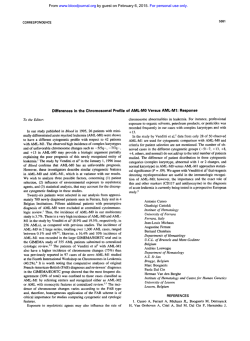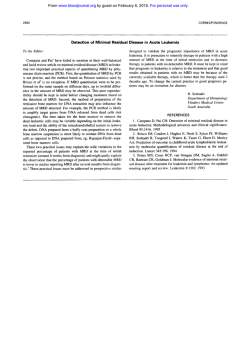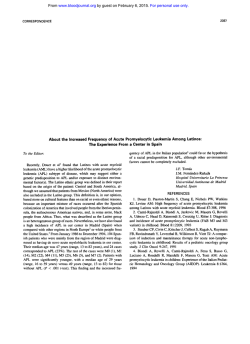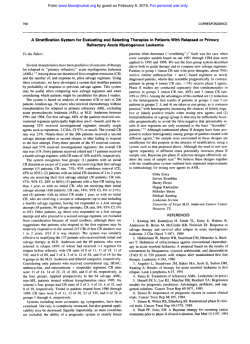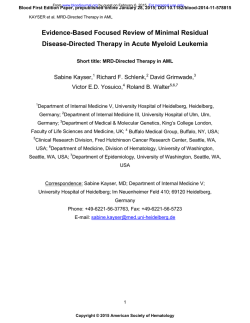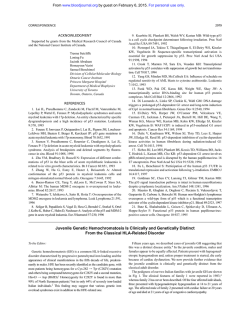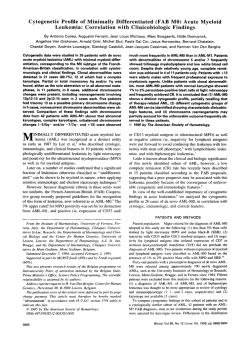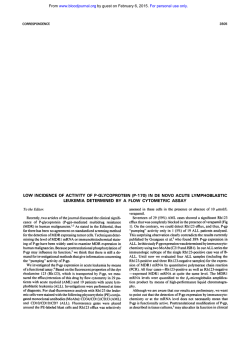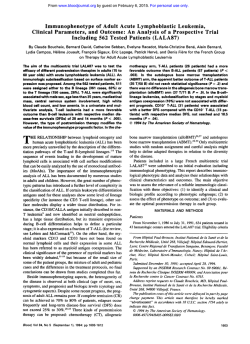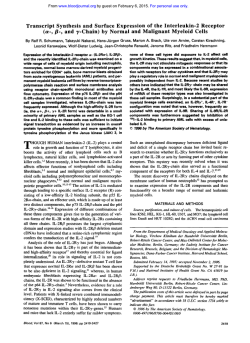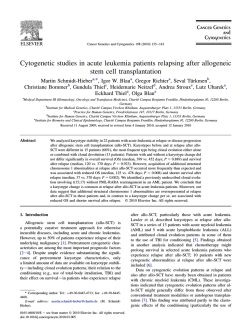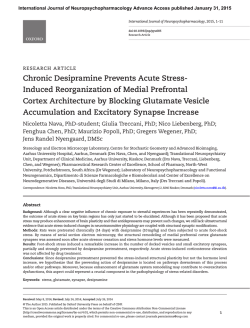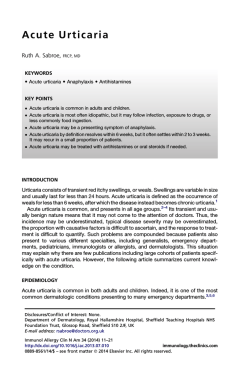
L-COT- -CD7*
From www.bloodjournal.org by guest on February 6, 2015. For personal use only. CORRESPONDENCE CD7 EXPRESSION IN ACUTE MYELOID LEUKEMIA To the Editor: The significanceof CD7 expressionin acute myelocyticleukemia (AML) has been discussed by Kita et al’ in a recent issue. We would like to contribute with our experience in 154 previously untreated AML patients observed between January 1987 and June 1992, median age 57 years. For remission induction, all patients received a combination of cytosine arabinosideand an anthracycline(patients <60 years) or mitoxantrone (patients >60 years). Immunophenotype studieswere performed on bone marrow blast cells using combinations of phycoerythrin (PE) and fluorescein isothyocyanate (F1TC)-conjugated monoclonal antibodies (MoAbs). Blast cells were selected on the basis of forward light scatter gating and a panmyeloid marker, either CD13 or CD33. An IgGh MoAb antLCD7 (Leu-9 FITC; Becton Dickinson, Mountain View, CA) was used. A positive reaction was considered when 20% or more of the gated cells expressed CD7 antigen. Fluorescence quantitative evaluation was performed by using an Epics Profile I cytometer (Coulter, Hialeah, FL). Interestingly, a review of one-parameter flow cytometry histograms showed that the CD7 fluorescenceintensity was low or intermediate. Results of incidence of CD7 positivity in each French-American-British (FAB) classificationcategory are detailed in Table 1. CD7 was positive in 49 cases (31.8%), being mainly expressed in the FAB MO and M5 groups and significantly correlated with CD34 (P < .001), HLA-DR (P = .018), white blood cell (WBC) count greater than 50 X 109/L (P = .038). The different percentage of positivity between the two studies might be related to the use of different anti-CD7 antibody isotypes. Fifteen cases of CD7+ simultaneously expressed TdT, but no case CD7+TdT+ showed cCD3. Besides, we found no correlation between CD7 positivity and hepatomegaly and/or central nervous system involvement. The complete remission (CR) rate was significantlylower in CD7+ patients (39% v 67%, P = .032). These cases also showed shorter survival (P < ,001) and decreased continuous complete remission (CCR) (P < .OO I ) (Fig 1, A and B). Moreover, in our series of patients, CD7+ cases with both CD2+ and TdT+ AML had a lower overall and disease-free survival than CD7- cases. We identified a phenotypic group with particular bad prognosis, the [CD7+CD14+](14.9%), selectively expressed in FAB M4 and M5 subtypes ( P< .OO 1 ). They responded poorly to standard chemotherapy for AML (CR rate: 32%) and had an unfavorable outcome (median survival: 16 f 2.8 weeks). Multivariate life-table analysis on several variables including age, WBC count, CD7, CD2, CD19, HLADR, CD34, and CD I4 confirmed the prognostic value of CD7 Table 1. Incidence of CD7+ Cases in FAB Classes FAB Group MO M1 M2 M3 M4 M5 Total CO7 EXPRESSION AN0 SURVIVAL A No. of CD7+ Cases Incidence 11 41 40 19 27 16 6 14 12 8 9 54.5 34.1 30 0 29.6 56.2 154 49 31.8 Total Tested 0 Blood, Vol 82, No 9 (November l ) , 1993: pp 2929-2932 (%I l n L-COT- I -CD7* P<0. 001 0.1 0 0 20 40 60 80 100 120 140 160 I I 180 200 WEEKS CO7 E X P R E S S I O N AND CCR B l n 0.8 P k 0.7 0 I L 0.4 I T 0.3 Y . !-- 0.2j 0.1 1 01 0 l11=19 I I 20 40 60 80 I , 100 120 WEEKS I 140 160 180 200 Fig 1. (A) CD7 expression at the time of diagnosis significantly affected survival duration. (B) CD7- cases had a much longer CCR than CD7+ cases. both with regard to survival (P = .001) and CCR duration (P = .018). In conclusion, as observed by Kita and other investigator^,"^ CD7 positivity can be considered to be a phenotypicalrisk factor for AML, and such an expression could identify a different clinical entity of AML. Giovanni Del Poeta Roberto Stasi Adriano Venditti Mario Masi Giuseppe Papa Cattedra e Divisione di Ematologia Universitb “Tor Vergata Ospedale S. Eugenio Rome, Italy ” 2929 From www.bloodjournal.org by guest on February 6, 2015. For personal use only. 2930 CORRESPONDENCE REFERENCES 1. Kita K, Miwa H, Nakase K, Kawakami K, Kobayashi T, Shirakawa S, Tanaka I, Ohta C, Tsutani H, Oguma S, Kyo T, Dohy H, Kamada N, Nasu K, Uchino H (The Japan Cooperative Group of Leukemia/Lymphoma): Clinical importance of CD7 expression in acute myelocytic leukemia. Blood 81:2399, 1993 2. Schwarzinger I, Valent P, Koller U, Marosi C, Schneider B, Haars 0, Knapp W, Lechner K, Bettleheim P: Prognostic significance of surface marker expression on blasts of patients with de novo acute myeloblastic leukemia. J Clin Oncol 8:423, 1990 3. Osada H, Emi N, Ueda R, Set0 M, Koike K, Suchi T, Kojima S, Obata Y, Takahashi T: Genuine CD7 expression in acute leukemia and lymphoblastic lymphoma. Leuk Res 14:869, 1990 4. Ball ED, Davis RB, Griffin JD, Mayer RJ, Davey FR, Arthur DC, Wurster-Hill D, Noll W, Elghetany T, Allen SL, Rai K, Lee EJ, Schiffer CA, Bloomfield CD: Prognostic value of lymphocyte surface markers in acute myeloid leukemia. Blood 77:2242, 1991 5 . Yumura-Yagi K, Hara .I, Kurahashi H, Okamura J, Koizumi S, Toyoda Y, Murayama N, lnoue M, Ishihara S, Tawa A, Nishiura T, Kaneyama Y , Okada S, Kawa-Ha K: Clinical significance of CD7-positive stem cell leukemia. Cancer 68:2273, 199t From www.bloodjournal.org by guest on February 6, 2015. For personal use only. 1993 82: 2929-2930 CD7 expression in acute myeloid leukemia [letter; comment] [see comments] G Del Poeta, R Stasi, A Venditti, M Masi and G Papa Updated information and services can be found at: http://www.bloodjournal.org/content/82/9/2929.citation.full.html Articles on similar topics can be found in the following Blood collections Information about reproducing this article in parts or in its entirety may be found online at: http://www.bloodjournal.org/site/misc/rights.xhtml#repub_requests Information about ordering reprints may be found online at: http://www.bloodjournal.org/site/misc/rights.xhtml#reprints Information about subscriptions and ASH membership may be found online at: http://www.bloodjournal.org/site/subscriptions/index.xhtml Blood (print ISSN 0006-4971, online ISSN 1528-0020), is published weekly by the American Society of Hematology, 2021 L St, NW, Suite 900, Washington DC 20036. Copyright 2011 by The American Society of Hematology; all rights reserved.
© Copyright 2025

